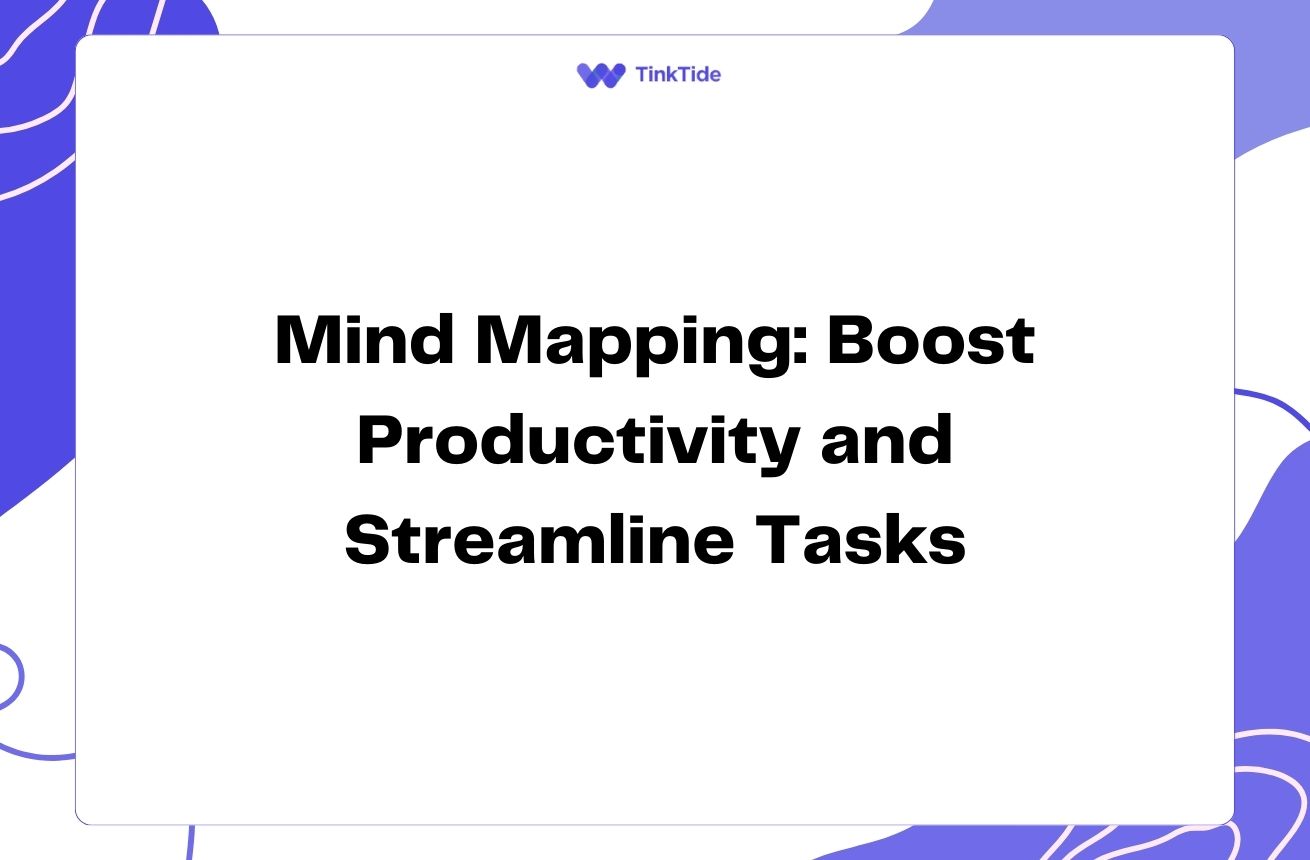Master Complex Projects with Mind Mapping Techniques
The Power of Mind Maps in Project Management
Mind mapping is a powerful visual tool that can revolutionize the way you approach complex project management. By creating a visual representation of your project's components, you can easily identify relationships, dependencies, and potential bottlenecks.
Using mind maps for project planning allows you to break down large, complex projects into manageable chunks. This visual approach helps you see the big picture while also focusing on individual tasks and their connections.
Research shows that visual information is processed 60,000 times faster than text, making mind maps an efficient way to communicate project details to team members and stakeholders. This visual clarity can lead to better decision-making and more effective project execution.
Let's explore some key techniques for using mind maps to plan and manage complex projects effectively.
Getting Started with Project Mind Mapping
To begin using mind maps for your complex projects, follow these steps:
- Choose a central topic or project name
- Identify main branches or project phases
- Add sub-branches for tasks and subtasks
- Use colors and icons for visual organization
- Include deadlines and resources on relevant branches
Creating a Project Overview Map
Start by creating a high-level project overview map. Place your project name or main objective in the center of the map. From there, branch out to include major project phases, key stakeholders, and primary goals.
This overview map serves as a visual project charter, helping team members and stakeholders quickly grasp the project's scope and structure. You can use tools like MindMeister or XMind to create digital mind maps that can be easily shared and updated.
Include important project milestones and deadlines on your overview map. This helps everyone understand the project timeline at a glance and keeps the team focused on key deliverables.
Remember to keep your overview map clean and uncluttered. You can create separate, more detailed maps for individual project phases or components as needed.
Breaking Down Complex Tasks
For each major project phase or component, create a separate mind map to break down complex tasks into smaller, manageable subtasks. This technique, known as 'progressive elaboration,' helps you plan in greater detail as you move closer to execution.
Use different colors or icons to categorize tasks based on priority, difficulty, or responsible team members. This visual coding makes it easy to identify critical path items and potential bottlenecks.
Include estimated time frames for each task and subtask. This will help you create a more accurate project schedule and allocate resources effectively. Tools like GanttProject can be used alongside your mind maps for detailed scheduling.
Don't forget to link related tasks across different branches or maps. This helps you identify dependencies and ensure smooth project flow.
Resource Allocation and Team Management
Use mind maps to visualize resource allocation and team responsibilities. Create a branch for each team member or department, then add sub-branches for their assigned tasks and projects.
This approach helps you quickly identify overloaded team members or underutilized resources. You can then adjust assignments to balance workloads and optimize project efficiency.
Include skill sets and expertise on team member branches. This makes it easier to assign tasks to the most suitable team members and identify areas where additional training or resources might be needed.
Consider using a tool like TeamGantt in conjunction with your mind maps to manage team workloads and track progress visually.
Risk Management and Contingency Planning
Mind maps are excellent tools for identifying and managing project risks. Create a dedicated risk management map with branches for different risk categories such as technical, financial, and operational risks.
For each identified risk, add sub-branches detailing potential impacts, likelihood, and mitigation strategies. This visual approach helps you prioritize risks and develop comprehensive contingency plans.
Use color coding to indicate risk severity, with red for high-risk items, yellow for medium risks, and green for low risks. This makes it easy to focus on the most critical issues.
Regularly review and update your risk management mind map throughout the project lifecycle. This ensures that new risks are identified and addressed promptly.
Tracking Project Progress
To track project progress effectively using mind maps, follow these steps:
- Update task statuses regularly (e.g., not started, in progress, completed)
- Use color coding or icons to visually represent task progress
- Add completion percentages to tasks and subtasks
- Highlight milestones achieved and upcoming deadlines
- Regularly review and adjust the project timeline as needed
Collaborative Mind Mapping for Team Engagement
Engage your team in the mind mapping process to foster collaboration and ensure buy-in. Use tools like Miro or Lucidchart that allow real-time collaborative editing of mind maps.
Encourage team members to contribute ideas, identify potential issues, and suggest improvements directly on the mind map. This collaborative approach can lead to more comprehensive project planning and increased team ownership.
Use mind mapping sessions as a brainstorming tool during team meetings. This can help generate new ideas and solutions for complex project challenges.
Remember to keep your collaborative mind maps organized and focused. Assign a facilitator to guide the process and ensure that all contributions align with the project goals.
Address common questions
Here are some frequently asked questions about using mind maps for complex project management:
How do mind maps differ from traditional project management tools?
Mind maps offer a more visual and flexible approach to project planning compared to traditional tools like Gantt charts. They allow for easy visualization of relationships between tasks and ideas, making them ideal for brainstorming and high-level planning. However, they can be used in conjunction with traditional tools for more detailed scheduling and tracking.
Can mind maps be used for very large, complex projects?
Yes, mind maps are scalable and can be used for projects of any size. For very large projects, you may need to create multiple interconnected maps, each focusing on different aspects or phases of the project. This allows for both detailed planning and a clear overview of the entire project structure.
How often should I update my project mind maps?
Project mind maps should be updated regularly, ideally on a weekly basis or whenever significant changes occur. This ensures that the maps remain accurate and useful throughout the project lifecycle. Regular updates also help identify potential issues early and keep all stakeholders informed of project progress.
What's the best way to share mind maps with stakeholders?
The best way to share mind maps depends on your stakeholders' preferences and technical capabilities. Digital mind mapping tools often allow for easy sharing via web links or exports to various formats (PDF, image, etc.). For non-technical stakeholders, consider presenting simplified versions of your maps during meetings or as part of project reports.
Can mind maps replace project management software?
While mind maps are powerful tools for planning and visualization, they typically work best when used in conjunction with project management software. Mind maps excel at conceptual planning and communication, while project management software offers features for detailed scheduling, resource allocation, and progress tracking. Combining both approaches can lead to more effective project management.
Provide additional resources
Mind Tools: Mind Mapping in Project Management
A comprehensive guide to using mind maps in project management
Project Management Institute: Visual Project Management
An article exploring the benefits of visual techniques in project management
MindMeister Blog: Project Management with Mind Maps
Practical tips and examples for using mind maps in project management
Lucidchart: Mind Mapping for Project Managers
A guide to creating effective project management mind maps
Tony Buzan: The Ultimate Book of Mind Maps
A comprehensive book on mind mapping techniques by the creator of modern mind mapping
Summarize key takeaways
Mind mapping is a powerful technique for planning and managing complex projects. By creating visual representations of project components, you can improve communication, identify potential issues, and streamline project execution.
Remember to use mind maps for high-level planning, breaking down complex tasks, resource allocation, risk management, and progress tracking. Combine mind mapping with traditional project management tools for optimal results.
Start incorporating mind maps into your project management workflow today. Experiment with different tools and techniques to find the approach that works best for you and your team. With practice, you'll discover how mind mapping can transform your project management process and lead to more successful outcomes.
Elevate Your Project Management Skills
Ready to revolutionize your project planning? Try our mind mapping tools and templates for free.
Start Your Free Trial

